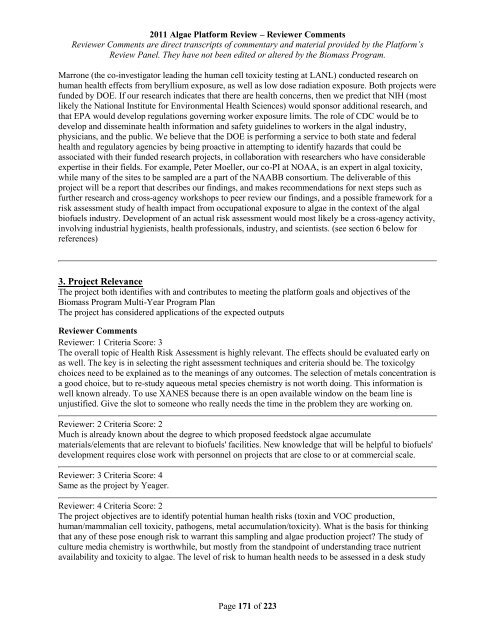Reviewer Comments - EERE
Reviewer Comments - EERE
Reviewer Comments - EERE
Create successful ePaper yourself
Turn your PDF publications into a flip-book with our unique Google optimized e-Paper software.
2011 Algae Platform Review – <strong>Reviewer</strong> <strong>Comments</strong><br />
<strong>Reviewer</strong> <strong>Comments</strong> are direct transcripts of commentary and material provided by the Platform’s<br />
Review Panel. They have not been edited or altered by the Biomass Program.<br />
Marrone (the co-investigator leading the human cell toxicity testing at LANL) conducted research on<br />
human health effects from beryllium exposure, as well as low dose radiation exposure. Both projects were<br />
funded by DOE. If our research indicates that there are health concerns, then we predict that NIH (most<br />
likely the National Institute for Environmental Health Sciences) would sponsor additional research, and<br />
that EPA would develop regulations governing worker exposure limits. The role of CDC would be to<br />
develop and disseminate health information and safety guidelines to workers in the algal industry,<br />
physicians, and the public. We believe that the DOE is performing a service to both state and federal<br />
health and regulatory agencies by being proactive in attempting to identify hazards that could be<br />
associated with their funded research projects, in collaboration with researchers who have considerable<br />
expertise in their fields. For example, Peter Moeller, our co-PI at NOAA, is an expert in algal toxicity,<br />
while many of the sites to be sampled are a part of the NAABB consortium. The deliverable of this<br />
project will be a report that describes our findings, and makes recommendations for next steps such as<br />
further research and cross-agency workshops to peer review our findings, and a possible framework for a<br />
risk assessment study of health impact from occupational exposure to algae in the context of the algal<br />
biofuels industry. Development of an actual risk assessment would most likely be a cross-agency activity,<br />
involving industrial hygienists, health professionals, industry, and scientists. (see section 6 below for<br />
references)<br />
3. Project Relevance<br />
The project both identifies with and contributes to meeting the platform goals and objectives of the<br />
Biomass Program Multi-Year Program Plan<br />
The project has considered applications of the expected outputs<br />
<strong>Reviewer</strong> <strong>Comments</strong><br />
<strong>Reviewer</strong>: 1 Criteria Score: 3<br />
The overall topic of Health Risk Assessment is highly relevant. The effects should be evaluated early on<br />
as well. The key is in selecting the right assessment techniques and criteria should be. The toxicolgy<br />
choices need to be explained as to the meanings of any outcomes. The selection of metals concentration is<br />
a good choice, but to re-study aqueous metal species chemistry is not worth doing. This information is<br />
well known already. To use XANES because there is an open available window on the beam line is<br />
unjustified. Give the slot to someone who really needs the time in the problem they are working on.<br />
<strong>Reviewer</strong>: 2 Criteria Score: 2<br />
Much is already known about the degree to which proposed feedstock algae accumulate<br />
materials/elements that are relevant to biofuels' facilities. New knowledge that will be helpful to biofuels'<br />
development requires close work with personnel on projects that are close to or at commercial scale.<br />
<strong>Reviewer</strong>: 3 Criteria Score: 4<br />
Same as the project by Yeager.<br />
<strong>Reviewer</strong>: 4 Criteria Score: 2<br />
The project objectives are to identify potential human health risks (toxin and VOC production,<br />
human/mammalian cell toxicity, pathogens, metal accumulation/toxicity). What is the basis for thinking<br />
that any of these pose enough risk to warrant this sampling and algae production project? The study of<br />
culture media chemistry is worthwhile, but mostly from the standpoint of understanding trace nutrient<br />
availability and toxicity to algae. The level of risk to human health needs to be assessed in a desk study<br />
Page 171 of 223




